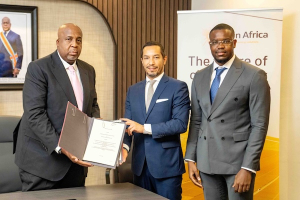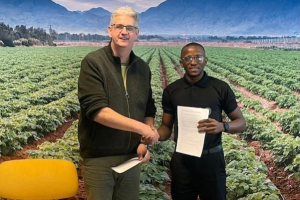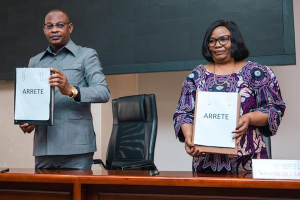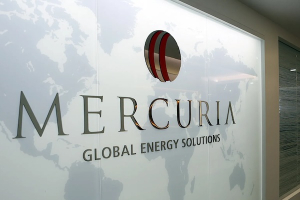Equipe Publication
Programme avec le FMI : la RDC en voie de recevoir plus de 450 millions $
La République démocratique du Congo (RDC) se rapproche d’un décaissement de près de 456 millions de dollars dans le cadre de son programme économique et financier triennal avec le Fonds monétaire international (FMI). Ce montant comprend 268 millions de dollars au titre de la Facilité élargie de crédit (FEC) et 188 millions de dollars au titre de la Facilité pour la résilience et la durabilité (FRD), précise une source interne.
Selon un communiqué du FMI, à l’issue d’une mission conduite du 22 octobre au 5 novembre 2025, les services du Fonds et les autorités congolaises sont parvenus à un accord préliminaire sur la deuxième revue du volet FEC et la première revue du volet FRD. Cette avancée marque la validation de la première étape vers le décaissement des 456 millions de dollars.
Les prochaines étapes concernent l’examen du dossier par la direction générale du FMI, puis par son conseil d’administration, dont la réunion est prévue en décembre 2025. Si le dossier reçoit un avis favorable — ce qui est probable, ces instances désavouant rarement les conclusions de leurs missions —, le décaissement interviendra immédiatement après.
Contrairement aux précédents versements, il s’agira en grande partie d’appuis budgétaires, c’est-à-dire de fonds transférés directement au Trésor public pour le financement du budget de l’État. Selon un responsable du FMI, 188 millions de dollars au titre de la FRD et 189 millions sur les 268 millions de la FEC seront versés sous ce mécanisme, soit un total de 377 millions de dollars.
Le solde de 79 millions de dollars sera crédité sur le compte de la Banque centrale du Congo (BCC) logé auprès de la Banque des règlements internationaux (BRI), afin de renforcer les réserves internationales du pays.
Cette répartition reflète les besoins économiques actuels de la RDC. D’après le FMI, la stabilité extérieure du pays s’est renforcée, soutenue par l’accumulation continue des réserves internationales et la réduction du déficit du compte courant, bien que le niveau des réserves demeure inférieur au seuil d’adéquation recommandé. Parallèlement, le conflit armé à l’est du pays et les épidémies récurrentes, comme celle de la maladie à virus Ebola, continuent d’exercer une pression importante sur les finances publiques.
Pour 2026, la RDC prévoit un budget de 59 020,5 milliards de francs congolais (FC), soit 20,3 milliards de dollars au taux de change moyen retenu dans les hypothèses budgétaires. Près de 15 % de ce budget, en hausse de 16,4 % par rapport à la loi de finances rectificative de 2025, sera consacré à la défense nationale, soit 7 929,7 milliards de FC (2,7 milliards de dollars). Pour financer ce budget, le gouvernement compte en partie sur les appuis budgétaires, attendus à 3 800,2 milliards de FC (1,3 milliard de dollars), en hausse de 28,1 % par rapport à 2025.
Pierre Mukoko
Lire aussi :
Le FMI décaisse 262 millions $ pour renforcer le matelas de devises de la RDC
Budget 2025 : le FMI et la Banque mondiale atténuent l’impact de la crise à l’est de la RDC
Sun Africa to develop 4,000 MW renewable energy project in DR Congo
The Democratic Republic of Congo (DR Congo) and U.S. developer Sun Africa signed in late October 2025 a memorandum of understanding to implement a program called “Energy for Prosperity,” according to Mike Luntadila Koketua, president of MFS Group, which serves as the developer’s local partner.
According to Luntadila, the program aims to install generation infrastructure with a total capacity of 4,000 MW by combining solar power, hydropower, and energy storage. It also includes plans to reinforce high- and medium-voltage transmission lines to modernize the national grid and support the country’s industrial transformation.
This is a large-scale initiative. For context, the Electricity Sector Regulatory Authority (ARE) estimated the country’s installed capacity at 3,646.5 MW in 2024, meaning the project’s planned capacity exceeds current levels. However, several details remain unclear, including the exact location of the plants, construction timeline, and financing structure.
Sun Africa describes itself as a developer of large-scale renewable energy and off-grid electrification solutions, including mini-grids and solar kits, across Africa. Its projects so far range from 25.4 to 370 MW, mainly in Angola, with rural electrification initiatives also planned in Nigeria and Namibia.
Based in Miami, the company announced in August 2024 that it had become the “new private partner” of the Power Africa initiative, under a plan to add up to 6,500 MW of new capacity and connect more than eight million households and businesses across the continent.
Mines : sept entreprises perdent leurs titres pour non-paiement des droits superficiaires
La République démocratique du Congo (RDC) poursuit sa politique de fermeté dans la gestion du domaine minier. Fin octobre 2025, le ministère des Mines a déchu sept entreprises de leurs titres miniers pour non-paiement des droits superficiaires.
Selon la liste publiée le 3 novembre par le Cadastre minier (CAMI), la société Geocore est la plus touchée, avec deux titres miniers déchus. L’un de ces titres, octroyé en 2021, couvrait cinq carrés miniers situés dans les territoires de Nyunzu et Kongolo, dans la province du Tanganyika. Il autorisait la société à mener des travaux de recherche et de prospection sur l’or, la cassitérite, le coltan et le wolframite dans ce périmètre.
La deuxième entreprise qui retient l’attention est Regal Maniema. Son permis de recherche n°3279 avait déjà été menacé de déchéance pour le même motif. Une procédure similaire avait été engagée en 2021, lorsqu’elle avait été épinglée pour non-paiement des droits relatifs à l’exercice 2019.
Ces décisions de déchéance s’appuient sur l’article 289 du Code minier révisé en 2018, qui stipule que les entreprises concernées peuvent introduire un recours devant les instances compétentes dans un délai de trente jours suivant la notification et l’affichage de la décision. À défaut, la déchéance est inscrite au registre du Cadastre minier et publiée au Journal officiel.
Le paiement des droits superficiaires constitue, selon le Code minier, la deuxième condition essentielle pour le maintien de la validité d’un titre minier, après la preuve du commencement effectif des travaux de recherche ou d’exploitation. Ces droits sont dus chaque année, calculés en fonction de la superficie du périmètre concerné et de la période de validité du permis. Leur montant varie entre 0,03 et 1,14 dollar par hectare, payés en francs congolais selon le taux de change en vigueur.
Timothée Manoke
Lire aussi :
Mines : des titres de Tenke Fungurume, Cilu… menacés pour non-démarrage des travaux
Mines : Cimenkat, Golden Africa et d’autres sociétés perdent leurs titres
Mines : la RDC fixe les travaux à réaliser pour garder un titre minier
Internet : Africell et Vodacom envisagent un partenariat avec Starlink en RDC
Les opérateurs télécoms Africell et Vodacom, actifs en République démocratique du Congo (RDC), explorent une collaboration avec Starlink, le fournisseur mondial d’accès Internet par satellite, en vue d’un partenariat destiné à étendre leurs réseaux sur l’ensemble du territoire.
Le directeur général d’Africell RDC, Kory Webster, a confirmé au média américain Semafor que l’entreprise menait des « discussions actives » avec Starlink pour un partenariat opérationnel. Un cadre de Vodacom, cité par le même média, a pour sa part indiqué que l’opérateur étudiait également une collaboration satellitaire, présentée comme une solution complémentaire pour renforcer la couverture dans les zones rurales et enclavées. Aucun détail supplémentaire n’a été communiqué.
Grâce à un accord signé en mai 2025 entre Airtel Africa et SpaceX, Airtel est déjà en partenariat avec Starlink en RDC. Les démarches de Vodacom et Africell apparaissent donc comme une réponse à cette avance concurrentielle.
Selon des experts, le réseau Starlink pourrait être utilisé pour relier les antennes-relais (BTS) situées dans les zones isolées au cœur des réseaux télécoms des opérateurs, là où transitent les communications et les données (voix, Internet, etc.). Cette solution représente une alternative moins coûteuse, en termes d’équipement et de déploiement, que la technologie VSAT actuellement utilisée. Un partenariat avec Starlink permettrait ainsi aux opérateurs de renforcer leur couverture tout en améliorant leurs performances commerciales et financières.
De ce fait, le partenariat entre Airtel Africa et SpaceX constitue un avantage stratégique pour la filiale congolaise d’Airtel dans la course aux 15 millions de nouveaux abonnés à l’Internet mobile attendus en RDC entre 2025 et 2030, selon les projections de la GSMA (Association mondiale des opérateurs de téléphonie).
D’après les données de l’Autorité de régulation de la poste et des télécommunications du Congo (ARPTC), à fin 2024, le pays comptait 32,94 millions d’abonnements actifs à l’Internet mobile (sur 90 jours). Airtel totalisait 9,66 millions de clients, soit 29,33 % de parts de marché, derrière Vodacom (37,78 %) et Orange (29,97 %), mais devant Africell (2,92 %). En revanche, sur le segment des revenus Internet, Airtel occupe la première place avec 365,5 millions de dollars (soit 37,7 % de parts de marché), devant Orange (31,5 %), Vodacom (27 %) et Africell (3,8 %).
Ronsard Luabeya
Lire aussi :
Airtel et Vodacom s’allient pour renforcer la couverture et la qualité de leurs services
Télécoms : 179 millions $ pour déployer 1 000 tours Orange–Vodacom en RDC
Internet par satellite : Starlink autorisé à opérer en RDC
Internet mobile : 15 millions de nouveaux abonnés attendus en RDC d’ici 2030
Sécurité aux frontières: le contrat de l’Américain Securiport au cœur d’un malentendu en RDC
Quelques extraits du contrat signé entre le gouvernement congolais — via le ministère de l’Intérieur et le ministère des Transports — et la société américaine Securiport, pour la mise en place d’un système intégré de gestion des services de sécurité et d’immigration en République démocratique du Congo (RDC), circulent sur les réseaux sociaux depuis le 3 novembre 2025, suscitant une vive polémique. En cause : l’article 38 relatif à la rémunération du partenaire privé.
Cet article mentionne une redevance de sécurité de 30 dollars à facturer à chaque passager aérien, à l’arrivée comme au départ, dans tous les aéroports internationaux du pays. Cette disposition a été interprétée par plusieurs internautes comme l’instauration d’une nouvelle taxe aéroportuaire, dans un contexte où la population réclame depuis longtemps la suppression d’autres prélèvements similaires, notamment le GoPass, fixé à 50 dollars pour les vols internationaux et 15 dollars pour les vols domestiques.
Cependant, selon un responsable du ministère de l’Intérieur, cité par plusieurs médias, cette redevance existe déjà. Elle est intégrée dans le prix des billets d’avion pour les vols internationaux à destination ou en provenance de la RDC, et perçue par les compagnies aériennes opérant sous code IATA. Ces recettes, jusque-là affectées à différentes administrations, dont la Direction générale de migration (DGM), ont été partiellement réaffectées au financement du contrat de Securiport LLC, précise la même source.
Cette version est confirmée par plusieurs compagnies aériennes, qui affirment verser déjà une taxe d’embarquement et de sécurité aux autorités congolaises. Dans leurs structures tarifaires, certaines compagnies comme Qatar Airways, Uganda Airlines et Kenya Airways mentionnent un montant de 43,75 dollars, tandis qu’Ethiopian Airlines affiche 58 dollars et Air France jusqu’à 66 dollars.
Mécanisme de gestion des fonds
D’après le contrat, la redevance de sécurité de 30 dollars sera désormais versée mensuellement sur un compte conjoint que le gouvernement et Securiport ouvriront ensemble. Le document précise qu’une instruction irrévocable de transfert mensuel des fonds sera appliquée, répartissant 85 % des montants à Securiport — pour amortir son investissement — et 15 % à l’État congolais.
Le contrat entre le gouvernement et Securiport repose sur un partenariat public-privé (PPP) de type Build–Train–Maintain–Transfer (BTMT). Il prévoit la mise en place d’un système intégré de gestion des services de sécurité et d’immigration, incluant l’installation d’équipements technologiques, la centralisation des données migratoires et la gestion numérique des flux de passagers dans les aéroports internationaux, les postes frontaliers et les ports du pays.
Securiport est chargée de financer, concevoir, installer et maintenir ce système, tout en formant les agents désignés par les deux ministères. À l’expiration du contrat — dont la durée n’est pas précisée dans les extraits disponibles —, la propriété complète du système (infrastructures, équipements et logiciels) reviendra à l’État congolais.
Pour le gouvernement, ce projet vise à renforcer les dispositifs de sécurité face à la recrudescence des menaces transnationales : falsification et contrefaçon de documents, fraude identitaire, infiltration d’individus radicalisés ou activités criminelles liées à la circulation internationale. En somme, il s’agit d’une réponse aux défis de sécurité aéroportuaire et frontalière auxquels la RDC est confrontée.
Securiport, basée en Virginie (États-Unis), se présente comme une entreprise spécialisée dans le contrôle de l’immigration et la sécurité de l’aviation civile. Elle opère déjà dans plusieurs pays africains — Côte d’Ivoire, Sierra Leone, Sénégal et Gambie — où elle fournit des services similaires. Dans ces pays, la redevance de sécurité varie entre 20 et 25 dollars ; en Gambie, par exemple, 25 % des montants perçus sont reversés à l’Autorité gambienne de l’aviation civile (GCAA).
Aucune communication officielle n’a pour l’instant précisé le processus ayant conduit au choix de Securiport. Selon une source proche de l’exécutif, la procédure aurait débuté il y a une dizaine d’années, et le choix de la société américaine serait issu d’un appel d’offres.
Jusqu’à présent, aucune déclaration officielle du gouvernement n’a été faite sur ce dossier, ce qui alimente les interrogations et n’apaise pas les inquiétudes au sein de l’opinion publique.
Timothée Manoke
Entretien de routes agricoles : le PNDA vise 707 km au Kasaï Central
Dans la province du Kasaï Central, un total de 707 kilomètres de routes de desserte agricole sont concerné par le Programme national de développement agricole (PNDA). Selon l’Agence congolaise de presse (ACP), qui cite une note officielle, les études techniques sont en cours et devraient s’achever d’ici fin 2025, en vue du lancement effectif des travaux en 2026.
Ces interventions visent à améliorer l’accès des zones de production aux marchés et à renforcer la connectivité rurale dans trois territoires : Demba (201 km), Luiza (246 km) et Dibaya (260 km), afin de soutenir les petits exploitants agricoles. Environ 70 % des travaux seront exécutés par la Direction des voies de desserte agricole (DVDA) selon la méthode haute intensité de main-d’œuvre (HIMO), « une méthode d’exécution de travaux publics qui privilégie l’emploi de la main-d’œuvre locale plutôt que l’usage intensif de machines ».
Un protocole d’accord a été signé le 24 février 2025 entre le PNDA et la DVDA pour accélérer la mise en œuvre du programme. Il prévoit notamment la formation des chefs d’équipe HIMO au sein des comités locaux d’entretien routier (CLER), des petites et moyennes entreprises (PME) et des organisations non gouvernementales de développement (ONGD) locales.
Financé par la Banque mondiale à hauteur de 300 millions de dollars, le PNDA couvre les provinces du Kasaï, Kasaï Central, Kongo Central et Kwilu. Le programme ambitionne de stimuler les chaînes de valeur agricoles, notamment celles du maïs amélioré, du manioc, du soja et de la volaille, tout en facilitant la circulation des produits agricoles. À terme, il prévoit la construction et la réhabilitation de 3 049 km de routes de desserte agricole à travers douze territoires des quatre provinces ciblées.
Ronsard Luabeya
Lire aussi :
Kongo central : la réhabilitation de 550 km de routes de desserte agricole lancé
Zones agricoles : Muhindo Nzangi et son projet de 11 000 km de voies de desserte
Énergie renouvelable : Sun Africa porte un projet de 4 000 MW en RDC
La République démocratique du Congo (RDC) et le développeur américain Sun Africa ont signé, fin octobre 2025, un protocole d’accord pour la mise en œuvre d’un programme dénommé « Energy for Prosperity », a annoncé Mike Luntadila Koketua, président du groupe MFS, qui se présente comme le partenaire local du développeur américain.
Selon M. Luntadila, le programme vise à installer des infrastructures de production d’une capacité totale de 4 000 MW, en combinant énergie solaire, hydroélectricité et stockage d’énergie. Le projet prévoit également le renforcement des lignes de transport haute et moyenne tension, afin de moderniser le réseau électrique national et de soutenir la transformation industrielle du pays.
Il s’agit d’un projet d’envergure majeure. Pour en mesurer l’ampleur, il suffit de se rappeler que l’Autorité de régulation du secteur de l’électricité (ARE) estimait la capacité installée du pays à 3 646,5 MW en 2024. Le programme vise donc une capacité supérieure à celle actuellement disponible. Toutefois, de nombreux détails restent à préciser : localisation exacte des centrales, calendrier de construction et modèle de financement n’ont pas encore été communiqués.
Sun Africa se présente comme un développeur spécialisé dans les solutions d’énergie renouvelable à grande échelle et un fournisseur de solutions d’électrification hors réseau (mini-réseaux, kits solaires) sur le continent africain. Jusqu’à présent, ses projets réalisés ou en développement vont de 25,4 à 370 MW et sont principalement situés en Angola. Des projets d’électrification rurale sont également envisagés au Nigéria et en Namibie.
Basée à Miami, l’entreprise avait annoncé, en août 2024, être le « nouveau partenaire privé » de l’initiative Power Africa, dans le cadre d’un plan visant à ajouter jusqu’à 6 500 MW de capacité électrique supplémentaire et à connecter plus de huit millions de foyers et d’entreprises sur le continent.
Boaz Kabeya
Lire aussi :
Ligne électrique Angola–RDC : l’Américain Hydro-Link boucle les accords préliminaires
Ruzizi III : l’Américain Anzana Electric en passe de devenir un partenaire stratégique
Est de la RDC : l’Américain Symbion Power rehausse à 700 millions $ son projet électrique
Frico Agri Signs MoUs with Dutch Firms to Strengthen Potato Production in DRC
Frico Agri, a Congolese company that produces frozen fries from locally grown potatoes, has signed three memorandums of understanding (MoUs) with Dutch firms, Delphy B.V., Go&Grow Farm Solutions, and Agrico B.V., to support the growth of the potato industry in the Democratic Republic of Congo (DRC).
The partnerships were formalized during a business visit to the Netherlands from October 13 to 30, 2025, led by Frico Agri founder Jean Johnson Bapanga. The mission received technical support from the Netherlands Enterprise Agency (RVO), the Dutch Embassy in the DRC, the Orange Corners program, and Ingenious City.
The planned collaboration with Delphy B.V. will focus on adapting agricultural practices to local growing conditions. The firm will offer expertise in sustainable soil management, integrated pest control, climate-smart farming, and technical training for local producers.
Go&Grow Farm Solutions will help Frico Agri modernize its operations by strengthening mechanization, upgrading storage facilities, and training local staff.
The proposed agreement with Agrico B.V. covers a 10-hectare pilot project to grow the Markies potato variety in Kongo Central province. The project includes varietal trials, producer training, and agronomic monitoring to improve yields and quality. Frico Agri expects the pilot to produce around 450 tons of potatoes per year, enough to keep its processing plant supplied between harvests.
Founded in 2019, Frico Agri has a monthly capacity of 20.8 tons of frozen fries, processing about 41.6 tons of potatoes. Internal reports show that since 2024, the company has faced two major bottlenecks: a shortage of high-quality seed potatoes for industrial processing and inadequate storage facilities. These challenges are linked to limited specialized potato cultivation and a lack of local expertise in varietal selection and post-harvest handling.
Frico Agri hopes to overcome these obstacles through the planned partnerships, though the signing dates and implementation timeline have yet to be announced.
Ronsard Luabeya
DRC Moves to Build Green Workforce, Train 100,000 Over Five Years
The Democratic Republic of Congo (DRC) has pledged to train 100,000 young people and women over the next five years for green jobs. The initiative forms the core of the National Green Jobs Development Plan (PNDEV), a program aimed at developing skills to meet the challenges of climate change.
The plan was officially endorsed during a workshop held in Kinshasa from October 21 to 28, alongside the National Register of Green Occupations. An inter-ministerial decree signed at the event gave both documents legal force.
Green jobs encompass activities that contribute to protecting and restoring the environment. The DRC has identified 84 such occupations, grouped into 11 professional categories covering fields such as sustainable agriculture, forest management, renewable energy, waste recycling, water management, and green hydrogen production.
The PNDEV, not yet publicly released, is described by officials as a key tool to align the country’s economic transformation with efforts to tackle both unemployment and climate change. In addition to training 100,000 young people and women, the plan includes purchasing training equipment, rehabilitating centers run by the National Institute for Professional Preparation (INPP), training instructors, and establishing a Green Jobs Observatory and an Information Hub.
Employment and Labor Minister Ferdinand Massamba wa Massamba hailed the approval as a “historic step” toward structuring the DRC’s labor market. He said the country now has a legal framework to align skills supply and demand in the green jobs sector, a sign, he added, of the government’s intent to align employment policy with the ecological transition.
Environment Minister Marie Nyange Ndambo said the new framework strengthens the DRC’s position in global climate talks linked to its Nationally Determined Contributions (NDCs). “By leveraging our natural resources through training and employment, we demonstrate that the DRC is not only the lung of the world but also a driving force in the ecological transition,” she said.
Prime Minister Judith Suminwa Tuluka urged ministries to integrate the green-jobs dimension into their sectoral programs. “The DRC wants to transition from being an ecological reservoir to becoming a global hub for green jobs,” she said, stressing the need to turn commitments into tangible results.
Boaz Kabeya
Mercuria Expands Copper Sourcing in DRC under $100 Million ERG Deal
Mercuria Energy Trading has signed a three-year deal to source copper from Eurasian Resources Group (ERG) operations in the Democratic Republic of Congo (DRC). The agreement, announced in a statement issued on October 30, 2025, includes a pre-financing facility of up to $100 million from Mercuria to ERG.
Details such as the loan’s interest rate, copper volumes, and pricing terms have not been disclosed. Off-take agreements of this kind are often viewed with suspicion by the Congolese government and state mining company Gécamines, which argue their interests are not always protected. Both are recipients of mining tax revenues and minority shareholders in several joint ventures, and have repeatedly demanded the right to market their production share directly.
The deal enables Mercuria to strengthen its supply from the DRC, following agreements reached in late 2024 and March 2025 to secure half of Gécamines’ copper entitlement from the Tenke Fungurume mine. Gécamines holds a 20% stake in TFM, which has annual production exceeding 450,000 tons.
ERG, 40% owned by the Kazakh state, is one of the DRC’s major copper producers. Through its subsidiaries Frontier and Metalkol, it sold 120,176 tons of copper in 2024, according to official data. Production could rise in the coming years, as ERG controls several other projects previously stalled by disputes with the government or Gécamines, including the Swanmines project, now set to resume after a settlement reached in September.
Mercuria said the financing aims to support the development of ERG’s operations in the DRC while strengthening the group’s trading portfolio and financial flexibility.
Founded in Geneva in 2004, Mercuria is one of the world’s leading commodities and energy trading firms. The DRC is “a region of growing strategic relevance,” said Kostas Bintas, the company’s Global Head of Metals and Minerals.
The DRC was the world’s second-largest copper producer in 2024, behind Chile, with output of 3.1 million tons. Demand for the metal continues to surge, fueled by the energy transition and artificial intelligence.
The International Energy Agency (IEA) estimates that global copper supply could fall short by 40% by 2035, a looming deficit that has helped lift prices nearly 20% over the past year, with futures trading around $11,500 a tonne on the London Metal Exchange.
Pierre Mukoko & Ronsard Luabeya














